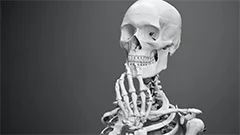Introduction
The hyoid bone is a unique and fascinating bone in the human body, positioned in the neck region and playing a crucial role in various anatomical functions. This course aims to provide an in-depth understanding of the hyoid bone, its structure, function, development, clinical significance, and evolutionary perspective.
Anatomy and Position
Overview
The hyoid bone is U-shaped and does not articulate with any other bones. It comprises three separate parts: the greater corpus, lesser corpus, and styloid process. The greater and lesser corpuses are fused posteriorly, while the styloid process projects inferiorly from the lesser corpus.
Location
The hyoid bone is located in the neck, deep to the investing layer of the deep cervical fascia. It lies just superior to the thyroid cartilage and encloses the larynx, pharynx, and esophagus within a ring-like structure called the hyoepiglottic ligament.
Structure
Components
Greater Corpus
The greater corpus is broader and larger than the lesser corpus. It has two processes: the posterior process, which is fused with the lesser corpus, and the lateral process, which extends towards the sides. The superior surface of the greater corpus bears a shallow depression called the basin of the hyoid.
Lesser Corpus
The lesser corpus is smaller than the greater corpus. It has two surfaces: the posterior surface, which is fused with the greater corpus, and the anterior surface, which faces the larynx. The superior margin of the lesser corpus bears a rounded projection called the tympanic notch, while its inferior margin bears the styloid process.
Styloid Process
The styloid process projects inferiorly from the lesser corpus and has a curved shape. It divides into two branches: the long and thin stylohyoid ligament medially and the stylomandibular ligament laterally.
Function
Muscular Attachments
The hyoid bone serves as an anchor for several muscles, including the stylohyoid muscle, stylopharyngeus muscle, thyrohyoid muscle, and geniohyoid muscle. These muscles play essential roles in swallowing, speaking, and various head movements.
Support and Protection
The hyoid bone supports the larynx, pharynx, and esophagus by forming a ring-like structure called the hyoepiglottic ligament. This arrangement allows these structures to move freely during swallowing while maintaining their relative positions. Additionally, the hyoid bone protects the vital neck structures from potential injury.
Development
Embryology
The hyoid bone develops from the first pharyngeal arch and appears as a horizontal bar in the fifth week of gestation. By the seventh week, it takes on its characteristic U-shape, and ossification begins around the tenth week. The greater and lesser corpuses are initially separate but eventually fuse posteriorly during the fetal period.
Clinical Significance
Injuries and Disorders
Injuries to the hyoid bone can occur due to blunt trauma, such as falls or motor vehicle accidents. Symptoms may include pain, swelling, difficulty swallowing, and a "click" sensation in the neck. Diagnosis is typically based on clinical examination and imaging studies like X-rays or CT scans.
Disorders of the hyoid bone are less common but can affect speech and swallowing abilities. Examples include goiter (enlarged thyroid gland) that presses against the hyoid bone, and certain congenital anomalies that result in abnormal hyoid development.
Evolutionary Perspective
Comparative Anatomy
In comparison to other mammals, humans have a unique hyoid bone structure due to our advanced speech and swallowing abilities. The human hyoid is more mobile and better adapted for these functions compared to other primates or carnivores. This adaptation is believed to have evolved as a consequence of the increased complexity of language development in humans.
Adaptive Value
The evolution of the human hyoid bone has significant adaptive value, enabling us to produce a wide range of vocalizations and sounds necessary for communication, as well as ensuring efficient swallowing mechanisms to facilitate our omnivorous diet.
Conclusion
The hyoid bone is an essential yet underappreciated component of the human body, playing crucial roles in speech, swallowing, and head movements. Its unique structure, development, and evolutionary adaptations reflect our species' complex communication abilities and dietary versatility. Understanding the hyoid bone provides valuable insights into human anatomy, physiology, and evolution.
MCQ: Test your knowledge!
Do you think you know everything about this course? Don't fall into the traps, train with MCQs! eBiologie has hundreds of questions to help you master this subject.
These courses might interest you
Create a free account to receive courses, MCQs, and advice to succeed in your studies!
eBiologie offers several eBooks containing MCQ series (5 booklets available free for each subscriber).



